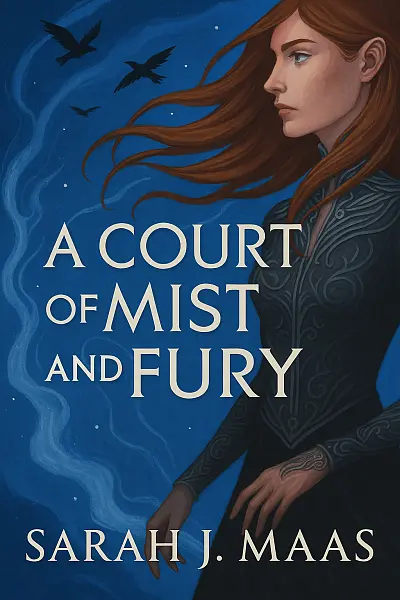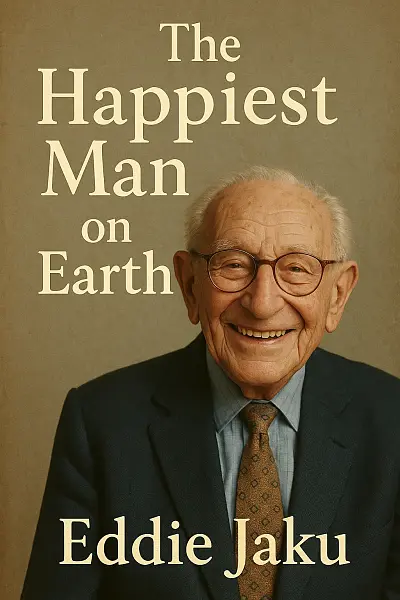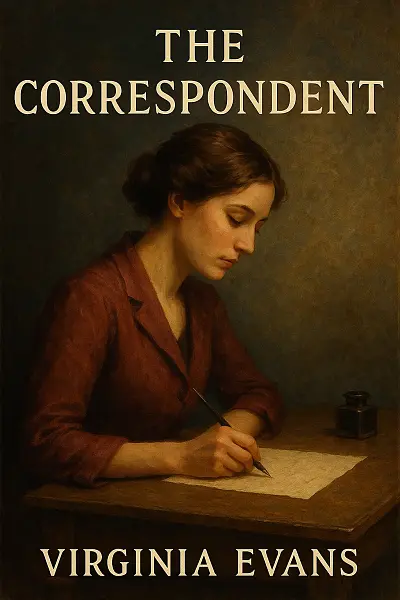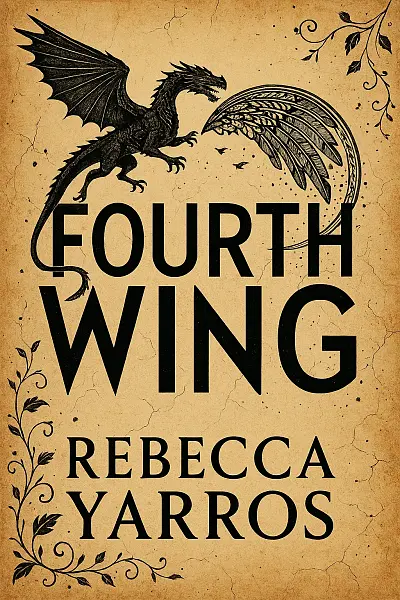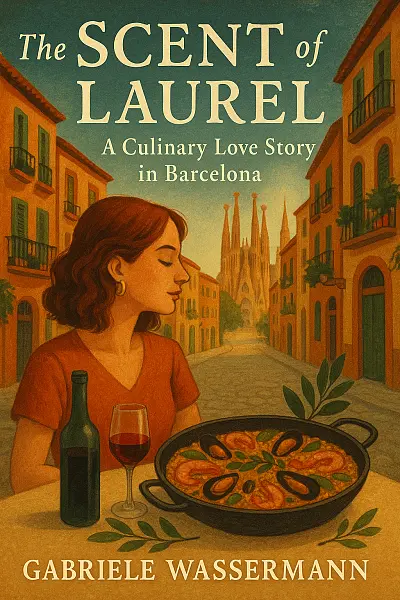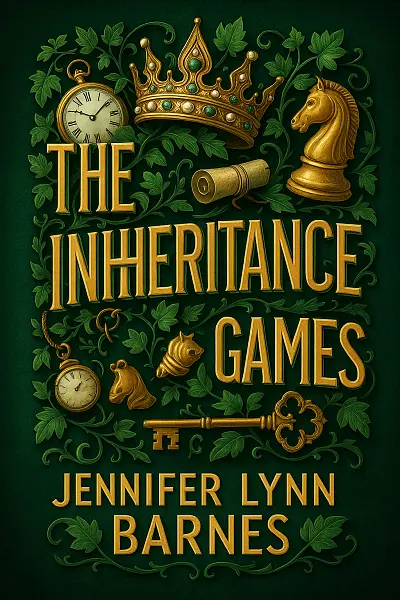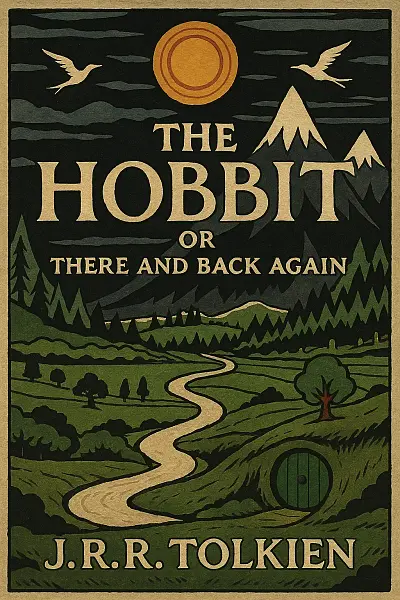
The Hobbit, or There and Back Again
by: J.R.R. Tolkien
Bilbo Baggins enjoys a peaceful, comfortable life in his hobbit-hole in the Shire, relishing quiet days and simple pleasures. One unexpected evening, the wizard Gandalf and a spirited group of dwarves show up at his door, pulling him into a wild quest to reclaim a treasure stolen by the fearsome dragon Smaug.
Bilbo, hesitant at first, is swept into a journey fraught with strange creatures and growing dangers. As the stakes rise, he must discover courage he never knew he had, risking not only his own safety but the fate of his new friends.
Told with warmth and whimsy, Tolkien’s storytelling crackles with adventure, humor, and the irresistible pull of stepping beyond your comfort zone—leaving readers wondering, will Bilbo rise to the occasion, or lose himself along the way?
""True courage is found when even the smallest heart dares to chase the unknown, trusting that home waits beyond every shadow.""
Literary Analysis
Writing Style
Atmosphere
Step into a world where comfort mingles with danger—cozy hobbit-holes, misty forests, gloomy mountains, and dragon-guarded halls. Tolkien crafts an immersive setting that feels almost tangible, drawing you into an old English fairy tale alive with both wonder and shadow. The mood shifts fluidly from homely warmth to epic risk, capturing the thrill of adventure and the ever-present echo of ancient magic.
Prose Style
Elegant yet approachable, Tolkien’s language is rhythmic and sometimes lyrical, sprinkled with bits of folksy humor and whimsical asides. There’s a clear storyteller’s voice running throughout—like an engaging fireside narrator who lets you in on secrets, jokes, and backstories. Occasionally, the sentences linger and wind, echoing the leisurely pace of a legend being recounted, but never tip into impenetrable territory.
Dialogue
Expect dialogue that shuffles between charmingly quaint and grandly formal. Dwarves grumble, Elves sing, and Gandalf just glows with enigmatic authority. The exchanges are often laced with wit or gentle sarcasm, making the characters feel alive, quirky, and distinctly individual.
Pacing
The plot walks a fine balance: it starts with the gentle meander of tea and cakes in Bag End, then steadily accelerates as the dangers ramp up. Tolkien isn’t in a rush—the story takes the time to wander through songs, riddles, and feasts. Some might find the detours enchanting; others may wish for a quicker path, especially in stretches like the lengthy trek through Mirkwood. The narrative pulses with slow-building tension interspersed with bursts of action and suspense.
Characterization
Bilbo Baggins shines as the everyman-turned-hero, and his transformation is both relatable and inspiring. The supporting cast leans heavily into archetypes: gruff dwarves, wise wizards, greedy trolls, but Tolkien gives each enough quirks and dialogue to feel distinct. While some characters don’t develop far beyond their types, their chemistry and banter give the journey real heart.
Sense of Wonder
Wonder is everywhere—creatures you’ve never imagined, landscapes that feel lifted from an illuminated manuscript, and a sense of adventure that’s both exhilarating and slightly perilous. Tolkien writes with a love for myth-making; even the smallest details feel touched with history and possibility, making every page a discovery.
Tone
Light-hearted and reassuring even amidst danger, the book always keeps one foot in the world of bedtime stories. The danger feels real, but the narration promises that wisdom, luck, and a bit of bravery might see you through. It’s a spirited, timeless tone—one part nostalgia, one part daring escapade—that makes the story endlessly re-readable.
Key Takeaways
- Bilbo swipes the Arkenstone—the tiniest hobbit, the boldest move
- Riddles in the dark: Gollum’s twisted wordplay and the birth of “Precious”
- Smaug’s thunderous monologues—witty, threatening, unforgettable
- Tolkien’s lyrical landscapes: Misty Mountains and Mirkwood practically breathe
- A band of dwarves, equal parts comedy troupe and tragic survivors
- From trembling “Burglar” to dragon-whisperer: Bilbo’s accidental hero’s journey
- Battle of Five Armies: chaos, heartbreak, and a surprising lesson in wisdom
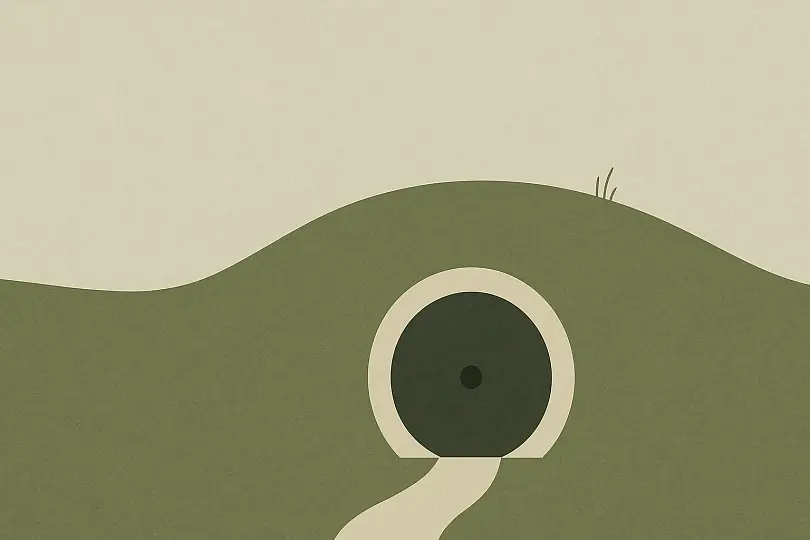
An ordinary hobbit’s quest becomes legend in a world of dragons and gold
Reader Insights
Who Should Read This
Who’s Gonna Love The Hobbit?
Alright, quick scoop: if you get a kick out of magical adventures, lovable underdog heroes, and a story that feels like an old campfire tale, this book is basically a must-read.
-
Fantasy fans, big and small: The Hobbit is classic fantasy gold, so if you’re into dragons, dwarves, or anything Middle-earth, you’ll be right at home. Even if you haven’t dipped your toes into fantasy before, this is a super-friendly starting point—no need to memorize ten thousand character names or lore pages.
-
Anyone who loves clever, courageous “unlikely heroes”: If you root for the little guy (literally—Bilbo Baggins is a hobbit, after all), this story is full of heart and gentle humor. Bilbo’s journey from comfort to adventure is half the joy.
-
Readers who appreciate beautiful, whimsical writing: Tolkien’s style is lush and poetic but also light on its feet—sort of like listening to your favorite grandparent spin a yarn. If you vibe with stories that feel like they’re being told to you, not just written down, you’ll get a real kick out of it.
-
Younger readers, families, or anyone looking to reconnect with their inner child: It’s written to be fun for kids, but honestly, there’s plenty for adults to enjoy—especially if you want something comforting or escapist.
Who Might Want to Skip This One?
-
Not big on description or slower moments? Tolkien loves his world-building—so if you’re the type who wants action on every single page, the slower, descriptive sections might test your patience.
-
Hoping for gritty realism or super complex, mature themes? This one’s more fairy tale than grimdark, so those who crave morally grey antiheroes or harsh realities might find it a bit too cozy.
-
Not into fantasy, period? If magic, talking creatures, and ancient riddles give you an instant eye-roll—there’s not much here to change your mind.
Bottom line: If you’re looking for an adventure that feels like a warm blanket—full of magic, wit, and heart—The Hobbit is a safe bet. If you hate the idea of dragons, songs, or old-fashioned adventures, you might wanna keep looking. But honestly? For anyone even remotely curious about fantasy, this is pretty much the gateway drug.
Story Overview
Ever wondered what might happen if an ordinary hobbit got swept up in an epic adventure? Join Bilbo Baggins as he reluctantly leaves the comfort of his cozy home to journey alongside a band of dwarves and the enigmatic wizard Gandalf in search of lost treasure. Along the way, he’ll face mythical creatures, tangled forests, and daring challenges—all wrapped up in a whimsical, magical, and unexpectedly heartwarming quest that’s equal parts danger and delight!
Main Characters
-
Bilbo Baggins: The unlikely hero and humble hobbit whose wit and bravery grow through his adventure. His personal transformation is the heart of the story.
-
Gandalf: The wise, enigmatic wizard who orchestrates the quest and offers crucial guidance, often nudging Bilbo toward courage and self-discovery.
-
Thorin Oakenshield: Proud leader of the dwarves, driven by his quest to reclaim his people's homeland. His struggle with greed and honor creates tension and depth.
-
Smaug: The cunning, fearsome dragon occupying the Lonely Mountain. Smaug's presence is the driving obstacle shaping the quest's dangers and stakes.
-
Gollum: A mysterious, pitiful creature encountered by Bilbo. Gollum's riddle contest and the discovery of the magic ring serve as pivotal moments in the story.
If You Loved This Book
If you’ve ever been swept away by the magic and camaraderie of Harry Potter and the Sorcerer’s Stone, you’ll find The Hobbit casts a similarly enchanting spell. The sense of wonder and discovery, vivid world-building, and the unlikely hero at the story’s heart create a familiar kind of comfort while inviting you into an imaginative adventure that’s entirely its own.
Fans of The Lion, the Witch and the Wardrobe will spot plenty of parallels in the journey from the ordinary to the extraordinary. Both stories whisk their protagonists—and readers—into lands brimming with danger and enchantment, where courage is forged and friendships are tested. There's a charming blend of whimsy and darkness, making The Hobbit especially suited for those who crave a fairytale with teeth.
On screen, Peter Jackson’s The Lord of the Rings trilogy echoes the spirit of Tolkien’s story with its breathtaking landscapes, tight-knit fellowship, and the constant push between personal comfort and epic responsibility. The quest for adventure—more reluctant for some than others—mirrors Bilbo’s gradual transformation, and both worlds are painted with the same rich brushstrokes of heroism, danger, and camaraderie. In short, The Hobbit offers the kind of escapism and depth that fans of epic fantasy books and films will instantly recognize and relish.
Expert Review
What does it mean to be brave, and can true heroism be found in the most ordinary of lives? The Hobbit sweeps us into a tale where comfort collides with destiny, daring us to imagine ourselves journeying beyond the safety of our own hobbit-holes. Through Bilbo Baggins, Tolkien asks: Must adventure always belong to warriors, or is it the quiet souls who surprise us most?
Tolkien’s prose in The Hobbit is a masterclass in balance—accessible yet rich, whimsical yet precise. He invites readers of all ages with a tone that’s part warm fireside storyteller, part sly humorist. The narrative voice occasionally breaks the fourth wall, but rather than distancing, it draws us closer, making the adventure feel intimate and conspiratorial. Vivid descriptions fill every page: forests are “dark and perilous,” mountains “grim and silent.” Dialogue is snappy, attuned to character, and tinged with both mischief and gravitas. Tolkien's language, while not as archaic as in The Lord of the Rings, remains lyrical—effortlessly blending songs, riddles, and mythic names into the text. Pacing oscillates between brisk encounters and sprawling travel sequences—a rhythm that sometimes lags but overall maintains momentum. Particularly striking is Tolkien’s command of atmosphere; whether it's the delicious coziness of Bag-End or the eerie gloom of Gollum's lair, setting is summoned to vibrant, tactile life.
At its heart, The Hobbit explores more than mere fantasy adventure. Themes of courage, greed, friendship, and the meaning of home permeate every turn. Bilbo’s personal growth—from comfort-loving bystander to resilient, resourceful participant—underscores the universal lure of transformation. The text slyly interrogates traditional heroism, with Bilbo’s cleverness and compassion offering a counterpoint to might and bravado. The dragon Smaug, a personification of destructive greed, holds a mirror to the ambitions and failures that haunt individuals and societies alike. Fascinating, too, is The Hobbit’s quiet environmental subtext: forests ruined by industry, ancient realms crumbling under avarice, and small folks striving to protect what’s precious. In today’s world—still grappling with displacement, environmental peril, and the allure of escapism—its themes are, if anything, more resonant now than ever.
The Hobbit stands as a keystone fantasy text, representing both an origin point for modern high fantasy and a bridge to Tolkien's more complex works. While The Lord of the Rings is grander in scope, The Hobbit's blend of fairy-tale atmosphere and quest narrative marks a uniquely inviting entry point for new readers. Within the broader tradition, its gentle subversion of epic conventions and emphasis on “ordinary” heroism established a template that still shapes the genre today.
Despite occasional pacing drag and a sometimes episodic structure, The Hobbit endures because it’s both timeless and personal—a work that invites us all to imagine heroism within ourselves. For lovers of fantasy and classic literature alike, it remains not just relevant, but essential.
Community Reviews
Bilbo’s “good morning” line absolutely lives rent-free in my head. A hobbit with manners accidentally insulting a wizard? Peak awkward politeness and somehow I think about it every time I say hello to strangers.
Bilbo sneaking into Smaug’s lair? I COULDN’T BREATHE. Every creak in my house sounded like dragon claws after that. Tolkien, why’d you do me like this? I needed sleep, not existential dread!
Bilbo Baggins really snuck into my dreams, I mean, one minute I’m reading about second breakfasts and suddenly I’m up at 3 a.m. plotting escape routes from goblins. Sleep schedule? Decimated. Thanks, Tolkien.
wasn't ready for gollum. that riddle scene? i woke up at 3 am thinking about "what have I got in my pocket?" and couldn't go back to sleep. to this day i avoid dark corners. thanks, tolkien.
Bilbo Baggins just wanted his tea, but suddenly he's running from trolls and riddling with Gollum in a pitch-black cave. I still mutter "What has it got in its pocketses?" at random times. That scene? Unforgettable.
Cultural Context & Discussion
Local Perspective
You know, The Hobbit feels surprisingly at home in British culture!
- Parallels with British history: Tolkien’s tale of modest folk thrust reluctantly into epic quests echoes how ordinary Brits faced upheavals like WWII—ordinary people doing extraordinary things in hard times.
- Cultural alignment: Bilbo’s love for comfort, tea, and order mirrors traditional English values. The Shire is almost a rural English idyll, and the reverence for home really hits Brits in the feels.
- Plot points that resonate: The dwarves’ reclaiming of their homeland whispers to memories of rebuilding after war or longing for lost glory—a vibe that echoes national sentiment.
- Local literary echoes: There's a cozy, pastoral vibe here that feels like it could sit beside Wind in the Willows or Alice in Wonderland, but Tolkien also challenges stuffy British heroism by making his hero anxious, humble, and non-traditional.
Bottom line? For many British readers, The Hobbit is both a nostalgic comfort and a playful nudge at what true courage looks like.
Points of Discussion
The Hobbit has been hugely influential, credited with laying the groundwork for modern fantasy literature—it's inspired generations of writers, sold over 100 million copies worldwide, and remains a beloved classic that introduced readers to Tolkien's enchanting Middle-earth.
